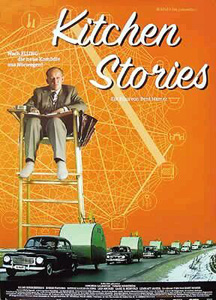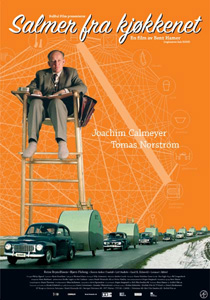![]()

![]()
(aka "Kitchen Stories" or "Psalmer från köket" or "Salmer fra køkkenet" or "Salmer fra kjøkkenet")
directed
by Bent Hamer
Sweden 2003
Norwegian director Bent Hamer, who had his breakthrough with
the quirky ”Eggs” (1995), continues with “Kitchen Stories” his unique brand of
social satire. Hamer has often been compared to Aki Kaurismaki, and while
there are similarities, Norway and Finland are very different in humour and
personality.
In the early 50s, the Swedish institute for housekeeping are doing research in
the patterns of activities in the kitchen, with the intention to ease and
increase efficiency in housekeeping activities. Part of this program involves
field studies, where lonely Norwegian men are observed in their daily
routines.
The story itself deals with the observer, Folke, and his subject, Isak, who by
mistake entered the program, as he thought he would get a real horse and not a
small wooden horse. Isak is very reluctant to be observed, he actually begins
to observe Folke, but little by little, the loneliness of the two turns into a
friendship.
The pace of “Kitchen Stories” is snail crawling slow. As scientific studies
require patience, patience and patience, so does Hamer use this mechanism to
put us, the viewer, into the chair of the observer, thereby extending the
boredom and loneliness onto us. By doing so, any reaction or distraction from
the daily routine, becomes a welcomed distraction, which in turn sets off the
quiet profound humour of Hamer. Of course the entire premise by the HFI is
naïve. Folke sits on his high chair in the corner, day in and day out,
pretending to be invisible, not allowed any contact or communication. It is
only a matter of time, before the loneliness becomes unbearable.
The point Hamer is making is, that human beings depend on interaction and
relations. Where the Swedes follow Taylorism as a religion (the caravan of
Volvo’s, driving on the left side of the road as it is scientifically safer,
the approach to the study), they break down when unable to live by it. One
researcher begins to drink with his subject, Folke reacts by eating himself
sick in Swedish food, and the team leader results to firing those who can't
stick to the program. As in all Hamer’s films, objects have symbolic value. In
“Eggs”, the eggs represents living in a shell, in “Water Easy Reach”, the
watch represents our dependency of time and in “Kitchen Stories”, the “chair”
represents the approach to other humans. While Folke remains an observer, he
sits in his high chair in the corner, only later to sit down next to Isak and
develop a friendship.
With “Kitchen Stories”, Hamer has created a unique social satire, slow, quirky
and full of heart. His best film to date and one of the best Scandinavian
films of 2003.
Posters
 |
 |
Theatrical Release: January 15, 2003 (Tromsø International Film Festival)
Reviews More Reviews DVD Reviews
DVD Review: Svensk Filmindustri - Region 2 - PAL
Big thanks to Henrik Sylow for the Review!
| DVD Box Cover |
|
CLICK to order from:
|
| Distribution |
Svensk Filmindustri Region 2 - PAL |
|
| Runtime | 1:30:50 (4% PAL speedup) | |
| Video |
2.1:1 Original Aspect Ratio
16X9 enhanced |
|
|
NOTE: The Vertical axis represents the bits transferred per second. The Horizontal is the time in minutes. |
||
| Bitrate |
|
|
| Audio | 2.0 Dolby Digital Swedish | |
| Subtitles | Danish, Swedish, Norwegian, Icelandic, English, None | |
| Features |
Release Information: Studio: Svensk Filmindustri Aspect Ratio:
Edition Details: Chapters 7 |
|
| Comments |
The picture is quiet hazy for
such a release. Note for instance the pattern on the cups and how its
impossible to see the details in the pattern. The bitrate is also
surprisingly flat. It would be interesting to compare this version to the
recent released UK version. As additional material, the DVD starts out with a slideshow, then continuing to deleted scenes. While the running time says 23 minutes, there are pauses, so its really only about 20 minutes, which by itself is a bit excessive, as it almost is a fifth of the actual film. Some of the scenes are really great, as the one where Folke and Isak are sitting and talking in the outhouse. Watching them back to back with the film, they give us a nice look into both the actual scenes and how the pace was constructed. The only thing missing here would be a commentary by Hamer to note upon this. Following this is a rather boring documentary about the shooting of the film. Its basically just a shots of the shooting with a rather incomprehensible commentary by the photographer. None of the extra material is subtitled. The covers suggests 2.35:1 (16x9). This is wrong. The actual AR is approx 2.1:1, which again is cropped from the theatrical AR of 1.85:1. Below is a shot taken from the deleted scenes. Note the differences. |
|
DVD Menus
|
|
|
|
|
|
Subtitle Sample
|
|
Screen Captures
|
|
Comparison to the deleted scenes (theatrical version) - note cropping
|
|
|
|
|
|
|
|
|
|


















